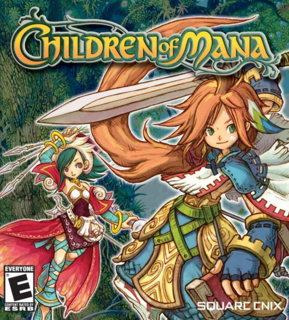Fun and challenging in its dungeon-crawlyness, but for those familiar with the series, it may not be what you expected.
In the center of the world, there is a Mana Tree, growing and protecting all those who inhabit it with its magic. But this power is now corrupting the spirits. Strange pillars of Mana energy appear everywhere, populating Illusia with monsters and the world is on the verge of a dark age.
It's up to a young adventurer and the Sword of Mana to restore the Mana Tree and save the world.
What first hit me was how the story was introduced. It's kinda just thrown at you, with little said, and off you go. And during further dialogs, it just doesn't seem all that interesting either. It's in the actual gameplay that things get interesting.
Children of Mana is basically a dungeon-crawler hack'n'slash. As you set out to the different parts of the land, you are taken through a series of levels until you eventually reach a boss fight and clear the area. Enemies are abundant in the battlefields, and while you can see some of them, others will only appear when you reach certain key spots. Many times you will find yourself surrounded by adorable creatures that are so cute that sometimes you feel bad for killing them.
For each dungeon you must find the Gleamdrop and take it to the Gleamwell to be transported to the next level. On the bottom screen you can get hints of where they are located (clear all enemies to find the Gleamdrop, Gleamwell is hidden by a block of ice, etc.). It does get repetitive (especially if you decide to go on side quests), and that's the game's major flaw.
For the most part, our hero attacks with a series of sword combos, but there is strategy involved when you start getting other weapons. The flail allows you to attack in circular motions and pull monsters or objects towards you. It's great for when you're surrounded and need a way out. The bow allows for ranged attacks and for charming monsters by using it as a harp. A heavy hammer is used to break certain obstacles and press switches, as well as making enemies slide and bounce off of walls, spiked floors and even each other, causing extra damage.
The ability to dual-weild isn't exactly what I had in mind when I first learned about it. Of all the weapons you receive, you get to have two active weapons at any given time, but you can't use both at once. You alternate between whichever is needed at the time. Progressing through the levels will require the use of all these weapons in specific occasions.
Elemental spirits are also available to help you on your journey. Although there are eight of them, you can only bring one with you at any given time. Spirits have both a defense and an attack spell, and can prove very useful.
Combat is pretty fast-paced, and killing enemies will gradually fill up your Fury meter, which you can then unleash in a series of quicker and more powerful attacks while it slowly depletes. What I found redundant was filling up the meter throughout the levels so I could use it at a boss fight, but when I entered the next level it would be empty again. So you might as well just use it as soon as it fills up.
A unique aspect of the game is the gem system that gives you boosters. Enemies and chests may drop gems that you can equip toy our gem frame to increase your attributes. In town, you can also find a gem store that offers a fusion service. Depending on what gems you have, you can mix and match to create more powerful ones. Some of the fusions are really quite expensive.
Hacking and slashing is actually quite fun, no matter how repetitive it may sound. The different areas of the world have specific obstacles and monsters, and when it comes to trying to kill things on a slippery icy surface or sand traps, the challenge increases considerably.
What was really frustrating was finding all those great weapons and armor during a level and not be able to equip anything until I reached the end of the stage. You have to wait until you've been through a series of levels to get into the Results screen, where you are given a score (and sometimes a prize) according to how well you did in the area and have the chance to change your equipment, revise your items and save your game. If you happen to quit or die before you reach one of these "interludes", you have to start that dungeon all over again. I shouldn't have to wait for a specific moment to equip something I just found and that's just right for my level.
Graphically speaking, Children of Mana is nicely animated, sharp and colorful, a delight to look at, especially in the cut-scenes. The music and sound effects are not too shabby either, but there is no voice acting, and I bet that is something that would have helped a lot with the presentation of the story.
Although the game is fairly short, there is an added multiplayer feature for up to four players to adventure in randomly generated dungeons which greatly adds to replay value and longevity. But that all depends on how much hacking and slashing you want to go through.
Overall, Children of Mana is not a bad game. It's still quite fun and challenging in its "dungeon-crawlyness" with the different weapons concept and frenzied combat. But for those who are familiar with the series, it may not be what you were expecting.
Review text part of Grrlgamer.com. Full text and screenshots at:
http://www.grrlgamer.com/review.php?g=childrenofmana

